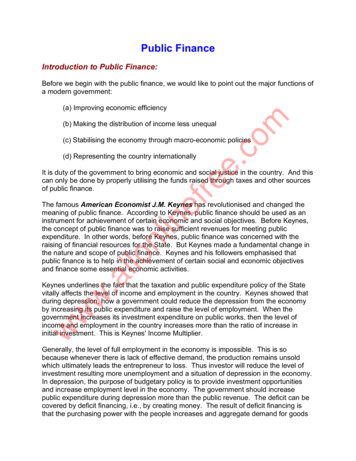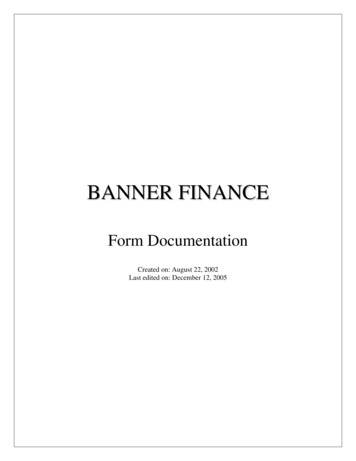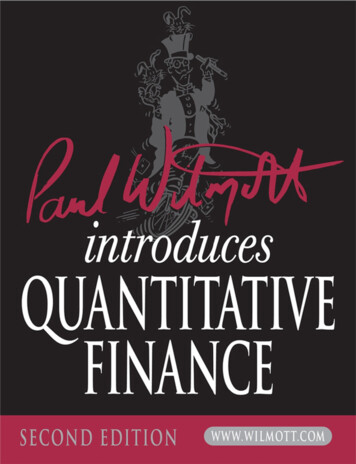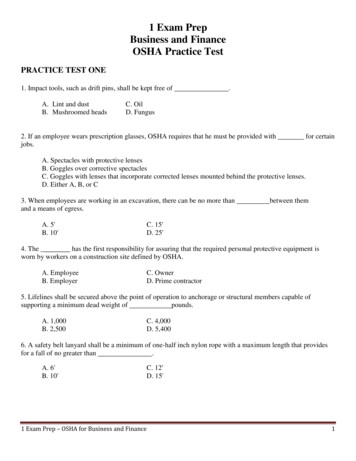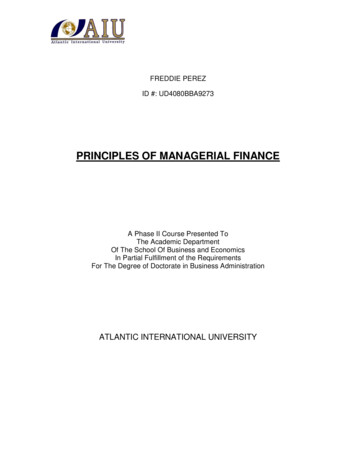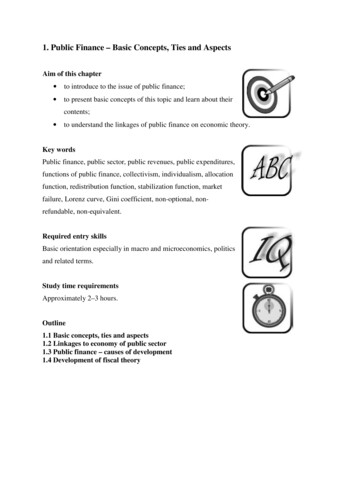
Transcription
1. Public Finance – Basic Concepts, Ties and AspectsAim of this chapter to introduce to the issue of public finance; to present basic concepts of this topic and learn about theircontents; to understand the linkages of public finance on economic theory.Key wordsPublic finance, public sector, public revenues, public expenditures,functions of public finance, collectivism, individualism, allocationfunction, redistribution function, stabilization function, marketfailure, Lorenz curve, Gini coefficient, non-optional, nonrefundable, non-equivalent.Required entry skillsBasic orientation especially in macro and microeconomics, politicsand related terms.Study time requirementsApproximately 2–3 hours.Outline1.1 Basic concepts, ties and aspects1.2 Linkages to economy of public sector1.3 Public finance – causes of development1.4 Development of fiscal theory
1.1 Basic Concepts, Ties and AspectsPublic finance as a concept may be understood on two levels – 1) as a practicalactivity of all components of public administration and 2) as a theoretical area.The term “public finance“ may be defined as the identification ofspecific financial relationships and functions running between publicadministration bodies and institutions (i.e. public sector entities – thestate) as one party and in mutual interaction with other entities of theeconomic system as the other party (i.e. private entities – householdsand companies).These relationships and functions may be considered special as they include: Procuring public goods (production and provision);arranging and funding various transfers (particularly in the social area);directing entities existing in the economy towards socially desirablebehaviours; for instance through taxes, penalties, subsidies and other stimuliand charges.In order to arrange the funding of the above-mentioned areas, there is a fiscal system(public budgeting system) whose aim is to collect the required amount of publicrevenue. Public revenue serves, at various levels of public budgets (governmental,regional and local), to fund public expenditures.Public expenditures, public revenue and particularly taxes may be considered to bethe fundamental elements of public finance. Important terms derived from these threeelements include deficit, public debt, budgetary policy and fiscal policy.The development of public finance is connected with economic mechanisms thatshould ideally lead to the effective and fair allocation of limited resources.Historically, allocation issues were dealt with through various allocationmechanisms. Cultural traditions and customs may be classified as initial allocationmechanisms. Later, with the advent of social and economic development, the role ofcustoms and traditions was taken over by the state. It contributed to making theallocation of limited resources effective and fair.Approximately since the 1930s, the state’s role in the economy hasbeen noticeably gaining in importance; therefore the traditionalfunctions of the state (legislative, social, security, etc.) have beensupplemented with the economic function (sometimes called the fiscalfunction or the public finance function). This function includesallocation, redistribution and stabilization activities. The state useslegislative and executive powers, as well as its own publicadministration bodies and institutions (centralized and decentralized) to perform them.The state is also a special economic entity because of its enforcement powers. Not onlydoes it determine rules, but it may also enforce their observance through the tools at itsdisposal.The state’s economic function has become predominant particularly in the school,health care, social services and social security sectors. With regards to the role of thestate in the economy, two approaches have emerged:
1) State interventions are undesirable for the economy; therefore they arerejected (individualistic views).2) State interventions are advocated (collectivist views).1.2 Linkages to Economy of Public SectorWhereas public finance relates to financial operations, relationshipsand tools for implementing the provision of public goods, transfers andthe stimulation of economic entities to follow a certain behaviour, theterm public sector means a specific part of the national economy.The institutions and organizations of the public sector are in whole or in part fundedby public funds and are connected with the fiscal system. Other specific characteristicsinclude their ownership, management system, provision of their products to consumers,etc. The public sector fills the gap unoccupied, for various reasons, by privatecompanies within their business activities.The public sector is a part of society that is in the public’s ownership, in whichdecisions are made by public choice, is under continuous public control, and exists forthe purpose of public interest fulfilment and common affair administration. The sectorthat is entirely or predominantly funded with private money and performs functionssimilar to those of the private sector is called the non-profit non-governmental sector.In pluralistic democracies, the public sector coexists with the private sector. Thesetwo sectors permanently influence each other with respect to both size and activity. Thestate strongly influences the private sector through various restrictive measures. One ofits control tools is public finance. Therefore, the public finance measures must beanalysed and examined, including how impact the private sector.1.3 Public Finance – Causes of DevelopmentThe reason for developing public funding is the state intention to soften thedrawbacks resulting from economic decisions made by individual entities (householdsand companies). It uses fiscal tools (public revenue and expenditure) to accomplish this.Certain behaviour is classified as the “quasi-fiscal funding principle”, where publiclaw goods are funded from off-budgetary resources (e.g. the public-law television inthe Czech Republic is funded from television licence fees).Another important term that relates to public finance, and that isalso a strong argument for its development, is market failure.The market system follows supply and demand through the pricemechanism. It is a system that has developed itself, and that has strongties with the interactions between people and companies. All these entities strive tomaximize their benefit (welfare). The greatest benefit is strongly interconnectedwith reaching the economic optimum condition. A system that reaches the optimum isconsidered, in the neoclassical economics concept, to be efficient, fair and stable. Theideal condition is called the Pareto optimum. This exists in an economy when none ofthe involved entities can improve its position without worsening another entity’s
position. If any of the entities intends to improve its position, it is possible for it to do soonly to the detriment of another entity. The existence of perfect competition is anecessary requirement for reaching the optimum.The three above-mentioned elements (efficiency, stability and fairness) areconnected with microeconomics from the viewpoint of efficiency, connectedwith macroeconomics from the viewpoint of stability, and connected with sciencesoutside economics from the viewpoint of fairness. The perception of fairness isinvestigated by other social sciences, and is closely linked to ethics, etc.If no conditions exist for reaching a market-efficient solution, or the conditions aresimply violated for any reason, market failure will ensue. It consists of the following: the allocation of resources is not efficient,the economy in the area of macroeconomics indicators oscillates around thedesired values andthe distribution of wealth and income may diverge from the consensus onfairness.It is then up to the state to perform its fiscal function (the public finance function) inthose three areas in order to preferably eliminate or at least reduce market failure.Specifically, those are microeconomic failures from the allocation function perspective,macroeconomic failures from the stabilization function perspective, and theredistribution function then falls into the area of market failure caused by outsideeconomies.If the conditions for perfect competition are not met, a malfunction in the pricemechanism will arise, which disturbs the allocation mechanism. Some failures can beeliminated without public finance intervention through auto-regulation (theinternalization of externalities). However, others are part of the government’s allocationfunction and its fiscal tools (taxes and governmental purchases or transfers).Macroeconomic failure is indicated by instability in the economic system thatusually suffers from cyclical inflation, a high rate of unemployment, low or evennegative growth of production or problems in the foreign trade balance, etc.The above-mentioned macroeconomic cases of instability are why governmentsperform the state stabilization functions (stabilization fiscal functions).The state uses several tools to perform the stabilization function. The basicclassification is a division into monetary and fiscal tools. The monetary tools includeopen market operations, the setting of basic interest rates, determining the level ofmandatory minimum reserves, etc. Fiscal tools may include public expenditure, publicrevenue and ways of funding deficits.The causes of market failure outside the economy relate to reaching fairness insociety through the distribution of wealth and income. With the distribution of wealth,the market does not practically perceive fairness. In this case, the state performs aredistributive role with 5h3 principles of solidarity, social conscience, charity, etc. basedon the social consensus.The state performs the redistribution function through two basic categories of tools.The first includes revenue (tax) and the other expenditures (transfers, grants and
subsidies). First, a tax transfer mechanism may be implemented through a combinationof progressive taxation of high incomes and transfers (subsidies) in favour of lowincome households. Secondly, this can occur through the taxation of luxury goodscombined with subsidies on goods for the low-income population.The question of fairness is further connected with incomeinequality. Its monitoring serves to seek necessary redistribution thatwill be perceived as fair by society. The most well-known tools are theLorenz curve (see Fig. 1), the Gini coefficient (G) and others.Percentage of income100%The curve of absoluteequality806040BReal income division200A20406080100%Percentage of populationFig. 1: Lorenz curveSource: own based on Hamerníková (2010).The formula for Gini coefficient is as follows: G is a dimensionless number and from the formula (1) is obvious that may havevalues within the interval of 0;1 , where zero means absolute equality and G 1means absolute inequality. The usual range of this coefficient lies between 0.3 and 0.6.Thus, with regards to absolute equality, the Lorenz curve is diagonal (see the curveof absolute equality in Fig. 1) and the Gini coefficient equals 0. In this case 20% ofpopulation has 20% of income, 40% of population 40% etc.Regarding the situation in Fig. 1 named “Real income division”. The poorest 20% ofthe population receives approximately 2% of income; 40% of population approximately10% and 60% of population receives approx. 20% of income.The coexistence of economic relationships between households andcompanies and the economic relationships and operations with publicadministration bodies and institutions (public finance) give rise to amixed economy. It lies at the frontier between an open marketeconomy and its opposite – a non-market (controlled) economy. Themixed economy contains, besides private ownership, also publicownership (i.e. state, municipal, communal, etc.)(1)
Three principles that public finance is based on are:1) Non-optional – Economic entities are forced by law to contribute to the joint budgetof national or local authorities. Although the entities must contribute, they are notguaranteed a sufficient amount of public goods.2) Non-refundable – The “quid pro quo” relationship in other finance or tradetransactions does not apply. It is not certain that the expended means will be returned tothe entities at the expected amount.3) Non-equivalent – Although the entities contribute to a joint fund, the benefit fromthe means expended by them is not equivalent (adequate) in view of the amount ofexpended means. Simply put, poor households contribute little, but the goods providedfor them by the public sector are relatively large. With regards to rich households, thesituation is reverse.Government failure is a specific risk regarding public funding. The governmentusually fails in the following items: The impact of measures taken by the government is often very difficult to assess(the problem of time and implementation lag).Auditing the consequences of taken measures is limited.Government decisions are actually implemented by clerks who may have theirown preferences.Political processes are special and may diverge from economic theories andneeds.1.4 Development of Fiscal TheoryWith regards to terminology, at the beginning of the 20th century,public finance was often called “state” or “municipal” or even “local”finance. Thanks to the transfer of powers from the state to autonomousregions, state administration and local administration may beunderstood as two different spheres. They fall under the combinedoverall title of public administration. It is then possible to call financial operations andrelationships between the components of public administration and their surroundings“public finance”.From the public finance concept perspective, a shift from the normative approachto the positive approach exists. The normative approach is based more on the deductionmethod, and it tries to define a system of unquestionable bases for governmental policyfrom the public finance perspective and the public sector (which means defining anaxiomatic system). The positive approach mainly uses the induction method whenanalysing the impacts of governmental measures on various economic entities.The foundations of the public sector economy based on a neoclassical economy are,by their nature, microeconomic. Since the Great Depression at the end of the 1920s, themacroeconomic approach was more common, especially beginning in the 1930s(functional – Keynesian finance). The situation lasted until about the 1970s, when thecontemporary crisis moved theoretical approaches again back to microeconomics.
2. Economic Analysis of Public GoodsAim of this chapter to get acquainted with characteristics of public goods; to understand the division of public goods; to be aware of the difficulties in effective ensuring ofpublic goods.Key wordsPublic good, collective consumption, free goods, economic goods,private goods, divisibility, rivalry in consumption, free rider,consumer community, externalities, effect of overloading.Required entry skillsTerminology, tools and graphical analysis of Microeconomics(preferably master level). Entry knowledge of public finance.Study time requirementsApproximately 2–3 hours.Outline2.1 Economic specifics and characteristics of public goods2.2 Classification of public goods2.3 Effective provision of public goods in terms of partial and general equilibrium
2.1 Economic Specifics and Characteristics of Public GoodsMicroeconomics theory states that the existence of public (goods ofcollective consumption) is one of the causes of market failure. Toeliminate this failure, a fiscal allocation function should beimplemented. A public goods analysis was performed by PaulSamuelson in 1954 with a specific focus on consumption. Public goods are not calledpublic because of the way they are financed, i.e., they are paid for and distributedthrough public finances, but because they are consumed in a very specific way. A publicgood does not have to be provided by public finances, even if this definition is what firstcomes to people’s minds.Division of goodsSome goods have mass availability for their consumers and they are neither producednor distributed. Their market price, naturally, is zero. Those are known as free goods(e.g. the air). This does not apply to most goods. The majority of goods have to beconcerned with allocation, production and distribution. These goods are calledeconomic.They can be divided into private goods and public goods. For privategoods, their important characteristics are their divisibility ofconsumption (consumer rivalry) and exclusion from consumption.Public goods are characterized by their indivisibility of consumption,zero marginal costs of consumption for each consumer and their nonexclusion from consumption. Assuming the above to be true, wedifferentiate between two marginal types of goods – pure private and pure public.For more information, see subsection 1.2.DivisibilityA very important attribute of economic goods is their divisibility among individuals.Some of them are divisible by both quantity and quality. However, not all goods aredivisible. Goods that have indivisibility of consumption share the followingcharacteristics: they are consumed by all consumers together,if they are only consumed by one entity, the consumption of other consumers isnot reduced.Divisibility (quantitative and qualitative) can be defined as follows: ,where:yk total consumption of a good k,xki consumption of a good k by a consumer i.The total consumption of good k equals the sum of partial consumption by alli-individuals.There are many fully-divisible goods in everyday (food, clothes, cars, electronics, etc.)(1)
On the other hand, full indivisibility means that every consumer consumes the sameamount. Whereas total consumption does not equal the sum of their partialconsumptions, as is the case for divisible goods, it equals partial consumptions. Therelationship between total consumption and the consumption of particular users can bedefined as follows: ,(2)where:yg total consumption of fully indivisible good g,xg1 consumption of a good g by a consumer 1,xgi consumption of a good g by a consumer i,xgn consumption of a good g by a consumer n.This is true for goods such as defence, security, street lighting, etc.Divisibility and indivisibility result in some microeconomic conclusions that areimportant for public finance. With regard to full divisibility, the following is important:Under the conditions of partial and general balance, it is possible to achieve theeconomically optimal state.For each pair of goods and pair of economic subjects, the following rule applies:MRSC, MRPT,(3)where:X a Y are two goods,PX a PY are market prices of these two goods,MRSCX,Y is a marginal rate of substitution in consumption of the goods X a Y,MRPTX,Y je is a marginal rate of transformation of the goods X a Y.Because of the full divisibility of goods, the following applies: The allocation of resources for producing goods may be effective with the helpof the system of prices.There is a competition among individual consumers. They cannot consume onegood together which reveals their preferences at the same time. This means thatat the same price, they will consume different amounts (the marginal utility MUfrom the last consumed unit by consumers A and B will equal the marginal costsMC for this unit of production, which will conveyed by the price of this unit –market demand is defined as the horizontal sum of partial demands. The pricemechanism then causes exclusion from the consumption of these fully-divisiblegoods.MU MU MC(4)With fully indivisible goods, the consumption of other consumers is not decreased bythe consumption of one consumer and the following applies: Consumption is non-rivalry; consumers do not reveal their preferences of theirown accord (a free rider suppresses his or her preferences on purpose).
It is either difficult or impossible to make an effective allocation decisionthrough the price mechanism. Nevertheless, balance exists when the totals of themarginal utility of consumers A and B, MUA and MUB, from the consumption ofa public good, equals the marginal costs MC of its production (demand for apublic good is defined by its vertical sum of partial demands).MU MU MC(5)From this relationship, it is obvious that unlike fully-divisible goods, the utility fromconsuming fully-indivisible goods by consumers A and B does not have to be the same.If it is not possible to make a consumer reveal their preferences (their MU) throughprices, then it is not possible to exclude those consumers who are not willing to “pay”for this public good from consumption. This is an example of the free rider problem.Problems connected to this reality can be found on two basic levels. One of them is thetheoretical level, which looks at the failure of market mechanisms in connection withthe non-effective allocation of public goods due to a functionless price mechanism. Thesecond level is practical problems, which are reflected in questions surrounding theproper amount and structure of public goods and next in questions concerning theallocation of production costs among all relevant consumers.Another characteristic of public goods is their selection andconsumption in particular consumer communities. This concernsvarious principles, i.e., geographical (the utility is for people in aparticular area), technical (the good is used for a specific technology –e.g. TV signals, Wi-Fi net), legal (the public good is, under certainconditions, only available for some people who belong to a particulargroup).Public goods and externalitiesPure public goods, which are indivisible in consumption, are in fact externalities. Anexternality is an internal relationship between two parties that unintentionally influencesthe utility of a third part – an uninvolved subject.2.2 The Classification of Public GoodsThere were two previously mentioned marginal types of goods fromthe point of view of their divisibility – pure private goods and purepublic goods. But these two types are rather hypothetical examples.There are many goods that only somewhat meet these definitions. Suchgoods are called mixed. For example, the effect of overloading oneconsumer causes a decrease in consumption by the second consumer(e.g. the use of surface communications – overloading causes a decrease of travellingspeed and safety).The following two pictures demonstrate the division of goods into pureprivate, pure public and mixed goods with regard to consumptionrivalry and exclusion from consumption (see Fig. 1). Second picture
presents the function of overloading as it relates to the effect of overloading during anincrease if the amount of a public good being consumed (see Fig. 2).EXCLUSIONNOT RIVALRYRIVALRYCONSUMPTIONACHIEVABLENOT ACHIEVABLEMIXED CLUBGOODSPURE PUBLICGOODSPURE PRIVATEGOODSMIXEDPOSITIONALGOODSFig. 1: Four groups of goods according to Samuelsons‘ criteriaSource: ownIf exclusion is achievable and the consumption is rivalry, we talk about pure privategoods. In case of the second extreme when exclusion is not achievable and theconsumption is not rivalry, we talk about pure public goods. If exclusion is achievable,but the consumption is non-rivalry, we talk about mixed club goods. And if exclusionis unachievable but the consumption is rivalry, we talk about mixed positional goods.BBminN*NmaxFig. 2: Effect of overloading – mixed public goodNote:NBBminN*number of users,the utility from a good for one user,minimal utility from a good (a user still remains),number of users with minimal utility.N
In the previous traffic example, point K illustrates the state of minimal traffic safety.Behind this point to the right, the utility of consumers rapidly decreases till it reacheszero.In assessing a fee for the use of mixed public good, the portion of users who will not bewilling to use it under these conditions is excluded (e.g. highway tolls). This situation isillustrated in Fig. 3.B, CfeeNfeeNmaxNFig. 3: Effect of introduction of a fee – mixed public goodNote:NBCNfeenumber of users,the utility from a good for one user,the costs of a good for one user,number of users after introduction of a fee.Other divisions of goodsOther possible divisions of goods exist according to economic andinstitutional criteria. The economic criteria were already described.Those were the criteria of exclusion and rivalry in consumption. Withinstitutional criteria, goods can be divided into pure market, impuremarket and non-market. With pure market goods, the market price isassessed on the basis of supply and demand. In the case of non-marketgoods allocation, the price mechanism cannot be applied and the state intervenes. Withsuch goods, price is assessed by some other way, not by the market (those are statediscriminatory measures). Other divisions can exist according to the spatial aspect ofpublic goods of national and local importance.2.3 Effective Provision of Public Goods in Terms of Partial andGeneral EquilibriumThe topic discussed in this chapter is one of the fundamental questionsof public finance. We previously mentioned the problem withconsumers who are not interested in revealing their preferences in thecase of the full indivisibility of public goods. We do not know theirindividual demand curve and it is difficult to determine aggregate demand. In such
cases, it is extremely difficult and even impossible to make an effective allocationdecision. From the practical point of view, it is a challenge for people who make publicfinance decisions to decide about: the proportion of the public or private security of goods,the subsequent private and public production of these goods,and last but not least, their optimal supply (amount and price),their optimal structure and provision (the amount of a particular good andhow to distribute it),or the optimal tax burden of individual consumers of these goods.Thanks to theoretical undetectability of the above mentioned aspects, this leads toestimates, analysis of costs and benefits, etc.Partial and general balanceIn brief, a partial balance means the achievement of the optimal state; it is the equalityof supply and demand on one (partial) market. A general balance means that theoptimal state has been achieved across all partial markets. In other words, supply anddemand are equal for every pair of goods and every pair of economic subjects.Public goods under a condition of partial and general balancePublic goods are by their nature so specific that they cannot be placed into the modelsof partial and general balance. The ideal solution for optimizing public goods is to equalthe marginal utility from the public good with the marginal loss caused by taxation.And what does a partial balance mean? On the market of private good, it is the situationdescribed in relationship (4).MU MU MCwhere: MUAMUBMC(4)marginal utility of a consumer A,marginal utility of a consumer B,marginal costs on produced good.We can again encounter the problem that for partial balance on the market with thepublic good, the following applies:MU MU MC(5)All consumers pay the same price for a private good, but they consume them indifferent amounts. With a public good, all individuals consume the same amount fordifferent “prices”. The total of these “different prices” should equal the costs ofproduction of that public good.The following graphic analysis (Fig. 4) should help to find the general balance in theconsumption of private good (X) and public good (G).
Consumer AConsumer AConsumer BFig. 4: Private and public good in general equilibriumIn the figure are two consumers, A and B, who have different preferences ofconsumption of private good X. That is why their indifference curves are different. Thelower part of the graph describes the curve of a given society’s production capacity. Thecurve f-f describes all the possible combinations of goods X and G that are available.The marginal rate of transformation (MRT) is the same for all goods. We will choose anarbitrary curve of consumer A called Aˈ. Then we will choose the amount of publicgood Gˈ. Now we can see that consumer A will consume the amount GˈA (it is XAˈ).We will find out from the limit of production capacity in the lower graph that in thiscase, consumer B will consume the amount corresponding to the difference (GˈE-GˈA);it is GˈN. Then, we will identify the corresponding indifference curve for consumer B,curve B1. You can see this curve in the lower graph as curve Bˈ1. Through this process,we will get the set of points that represent the consumption of private good X perconsumer A with the changing preferences of consumer B on the indifference curve B1This one can be seen in the left lower graph as the curve TT and it is obvious that theoptimal combination is the indifference curve A1, which is the tangent to TT at point O1.
The following can then be applied: MRT MRSAXG MRSBXG. The process repeats fordifferent levels of indifference curves when the set of optimal points O1 (i 1 to n)arises – see the upper graph on the right.In this case, the general balance enables us to define the amount of private and publicgoods, the price and the transfers.Exclusion from the use of a public good – the loss of utilityIn some cases, exclusion from the use of a good is possible. Implementing such ameasure could be expensive or the utility could be reduced.PriceCapacity of a goodDLoss of social utilityPQpQmaxQcapFig. 5: Loss of utility because of introduction of a feeNote: marginal costs are considered as zero.The loss of utility was demonstrated by J.E. Stiglitz with a toll that was collected forcrossing a bridge. If the capacity of the bridge is sufficient (Qmax), then the tollcollection (P) will reduce the utility. See Fig. 5 (the space with stars). If there are zeromarginal costs or the toll collection is too expensive, then it is better t
1. Public Finance – Basic Concepts, Ties and Aspects Aim of this chapter to introduce to the issue of public finance; to present basic concepts of this topic and learn about their contents; to understand the linkages of public finance on economic theory. Key words Public finance

